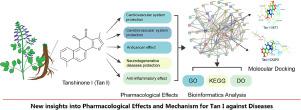Phytomedicine ( IF 6.7 ) Pub Date : 2022-12-27 , DOI: 10.1016/j.phymed.2022.154632 Liyuan Ke 1 , Chenhui Zhong 1 , Zhijie Chen 1 , Ziyao Zheng 1 , Shaoguang Li 1 , Bing Chen 2 , Qiaoyi Wu 3 , Hong Yao 4

|
Background
Tanshinone I (Tan I) is known as one of the important active components in Salvia miltiorrhiza. In recent years, Tan I has received a substantial amount of attention from the research community for various studies being updated and has been shown to possess favorable activities including anti-oxidative stress, regulation of cell autophagy or apoptosis, inhibition of inflammation, etc.
Purpose
To summarize the investigation progress on the anti-disease efficacy and effect mechanism of Tan I in recent years, and provide perspectives for future study on the active ingredient.
Method
Web of Science and PubMed databases were used to search for articles related to "Tanshinone I" published from 2010 to 2022. Proteins or genes and signaling pathways referring to Tan I against diseases were summarized and classified along with its different therapeutic actions. Protein-protein interaction (PPI) analysis was then performed, followed by molecular docking between proteins with high node degree and Tan I, as well as bioinformactic analysis including GO, KEGG and DO enrichment analysis with the collected proteins or genes.
Results
Tan I shows multiple therapeutic effects, including protection of the cardiovascular system, anti-cancer, anti-inflammatory, anti-neurodegenerative diseases, etc. The targets (proteins or genes) affected by Tan I against diseases involve Bcl-2, Bid, ITGA2, PPAT, AURKA, VEGF, PI3K, AKT, PRK, JNK, MMP9, ABCG2, CASP3, Cleaved-caspase-3, AMPKα, PARP, etc., and the regulatory pathways refer to Akt/Nrf2, SAPK/JNK, PI3K/Akt/mTOR, JAK/STAT3, ATF-2/ERK, etc. What's more, AKT1, CASP3, and STAT3 were predicted as the key action targets for Tan I by PPI analysis combined with molecular docking, and the potential therapeutic effects mechanisms against diseases were also further predicted by bioinformatics analyses based on the reported targets, providing new insights into the future investigation and helping to facilitate the drug development of Tan I.
中文翻译:

丹参酮 I:药理活性、抗病分子机制和未来展望
背景
丹参酮 I (Tan I) 是丹参中的重要活性成分之一。近年来,Tan I 受到研究界的大量关注,各种研究不断更新,并已被证明具有良好的活性,包括抗氧化应激、调节细胞自噬或细胞凋亡、抑制炎症等。
目的
总结近年来丹Ⅰ抗病功效及作用机制的研究进展,为今后活性成分的研究提供展望。
方法
使用Web of Science 和PubMed 数据库检索2010 年至2022 年发表的与“Tanshinone I”相关的文章。对涉及Tan I 抗疾病的蛋白质或基因和信号通路及其不同的治疗作用进行总结和分类。然后进行蛋白质-蛋白质相互作用 (PPI) 分析,然后进行高节点度蛋白质与 Tan I 之间的分子对接,以及生物信息学分析,包括对收集的蛋白质或基因进行 GO、KEGG 和 DO 富集分析。
结果
Tan I 具有多种治疗作用,包括保护心血管系统、抗癌、抗炎、抗神经退行性疾病等。Tan I影响疾病的靶点(蛋白质或基因)涉及Bcl-2、Bid、ITGA2、PPAT、AURKA、VEGF、PI3K、AKT、PRK、JNK、MMP9、ABCG2、CASP3、Cleaved-caspase-3、AMPKα、 PARP等,调控通路参考Akt/Nrf2、SAPK/JNK、PI3K/Akt/mTOR、JAK/STAT3、ATF-2/ERK等. 此外,通过PPI分析结合分子对接预测AKT1、CASP3、STAT3为Tan I的关键作用靶点,并基于已报道的靶点通过生物信息学分析进一步预测了潜在的疾病治疗作用机制,提供了新的思路。对未来调查的见解,有助于促进 Tan I 的药物开发。











































 京公网安备 11010802027423号
京公网安备 11010802027423号